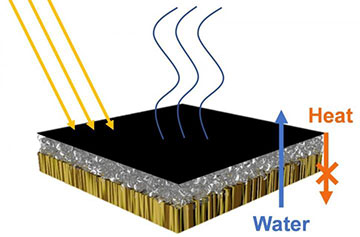
Schematic illustration of the solar steam generator. The top carbon nanotube layer (black) absorbs light and generates vapor. The grey bacterial cellulose layer blocks the downward heat flow and the brown wood layer transports water. [Image: Adapted from Nano Letters 2020, DOI: 10.1021/acs.nanolett.0c01088]
According to the United Nations, in the last century, water use has grown more than twice as fast as the global population. Two billion people live in countries experiencing high water stress.
One potential solution to this global challenge is solar distillation—a process that purifies contaminated water using sunlight. However, existing solar-distillation technologies have yet to hit on the opportune balance between low costs and high evaporation efficiencies.
Now, researchers in China have designed a high-efficiency, sustainable solar-distillation device that is based on a biomimetic design. By constructing bacterial cellulose (BC) nanocomposites in and on a wood substrate, the researchers have achieved a hierarchical solar steam generator (HSSG) that features a higher evaporation rate and efficiency than most existing SSGs. (Nano Lett., DOI: 10.1021/acs.nanolett.0c01088)
Dealing with water scarcity
“Solar-distillation technology can effectively separate clean drinking water from non-drinkable or contaminated water sources, so it has huge application potential in water-scarce areas,” says study co-author Guan Qing-Fang at the University of Science and Technology of China in Hefei, China. Furthermore, he says, the steam generated by the solar-distillation process can be used to heat or sterilize food—without electricity—which could come in handy in off-the-grid areas.
SSGs are an essential part of the solar-distillation process, and there are currently three main strategies for improving their efficiencies: increasing sunlight absorbance, enhancing thermal management and accelerating water transportation. The China team, however, also considered a fourth factor for optimizing its device—reducing water vaporization enthalpy (or the heat of vaporization) to increase the evaporation rate. To integrate all four components into one device, the team turned to nanocomposites.
Bound with bacteria
“Our research group has long been concerned about the synthesis of nanocomposites based on bacterial cellulose,” says Guan. In fact, just last year, the team published a method combining nanomaterial aerosol and biosynthesis of BC. In that work, the team realized that the nanocomposite materials were highly porous and demonstrated excellent hydrophilicity, says Guan; that, in turn, inspired the team to apply the method to water evaporation.
To assemble their nanomaterial-based device, the Chinese team began inoculating the bacterial strain onto a natural wood substrate. The researchers choose wood as the basis of their generator, as the material is both sustainable and naturally porous, allowing for quick water transport through the device. After inoculation, the bacteria began producing cellulose nanofibers, which integrated with the porous structure of the wood.
As the bacteria continuously secreted BC, the team sprayed an aerosol of glass bubbles onto the surface of the wood, which settled and became embedded in the cellulose nanofibers, forming a uniform hydrogel layer for thermal insulation. Next, the researchers sprayed a suspension of carbon nanotubes on top of the insulating layer to produce a light-absorbing, water-evaporating top layer. The bacteria continued to produce BC through each step of the process, so the carbon nanotubes became tangled in the nanofibers, binding the layers of the hierarchical device together.
The perks of automatic assembly
Through this self-assembly process, water is transported up through the wood to the light-absorbing layer, which is heated by the sun. The water then evaporates, generating steam, which is collected and condensed into contaminate-free water. Thanks to the nanocomposites, this process is relatively low energy, meaning the device achieves high-evaporation efficiency at normal temperature and pressure—all while using inexpensive raw materials.
“One of the most attractive features of our device,” says Guan, “is that it is automatically assembled during the biosynthesis process.” What’s more, he explains, “by changing the added nanomaterials,” such as switching out the glass bubbles for the carbon nanotubes, “different functional layers can be naturally formed, thereby realizing fully automatic assembly of the device.”
Aiding accessibility
In experiments, the device achieved a high evaporation rate of 2.9 kg m−2 h−1 and solar-to-vapor efficiency of 80%, which, the team writes, is the highest evaporation rate reported under 1 sun intensity.
According to Guan, these results contain two core novelties: “The first is that, for the first time, multiple factors such as light absorption, heat management, water transportation and reduced enthalpy of evaporation have been comprehensively controlled, significantly improving the efficiency of solar evaporation.” Secondly, he says, “this is the first fully automated solar-distillation device based on the biosynthesis process.”
This is significant, he says, as it makes solar-distillation technology much more accessible by simplifying device preparation. Based on these two points, Guan believes that his team’s generator could play a role in promoting the future application of solar distillation.
